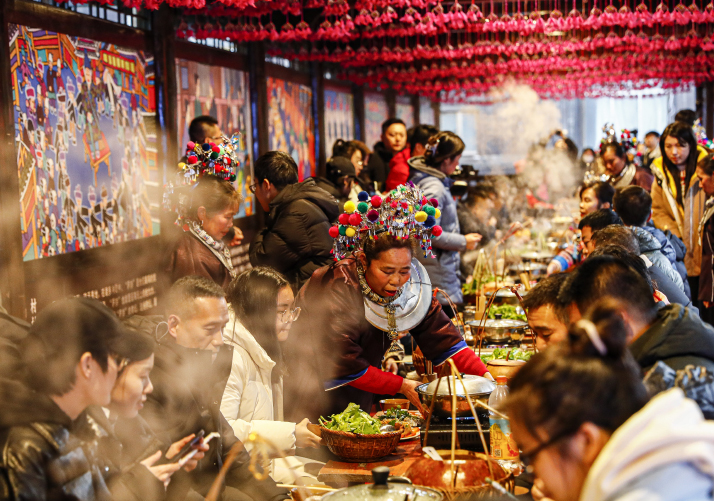
Since temperatures dropped at the end of last year, Harbin, capital of China’s northernmost Heilongjiang Province, has enjoyed unprecedented national prominence as a top destination for winter travel. With its picturesque winter landscape of snow and ice, hospitable locals and variety of cuisines, Harbin has welcomed millions of visitors this winter, especially from southern parts of the country where snow is rarely seen.
During the three-day New Year’s holiday, from December 30, 2023, to January 1, alone, Harbin received more than 3 million visitors, raking in tourism revenue of 5.91 billion yuan ($831 million). Both the number of tourists and the amount of tourism revenue surpassed the 2019 figures, reaching a historical peak.
Harbin’s phenomenal tourism boom has inspired other regions to come up with innovative ideas to boost their own tourism sectors. In addition to vying for visitors by constantly upgrading their attractions, products and services, tourism departments in various regions have also been interacting with each other on social media, helping promote each other’s tourist attractions and resources. These efforts have led to strong tourism momentum across the country, which is likely to last the whole of 2024, according to Zhang Yiqun, head of the Institute of Financial Science of Jilin Province.

More than luck
To some, the surge in Harbin’s popularity may seem abrupt, but this success is no stroke of pure luck. The city has been working on tapping its winter resources for years and waiting for the opportunity to shine in the way it has this season.
With the growing popularity of winter sports nationwide that accompanied the Olympic and Paralympic Winter Games Beijing 2022, Harbin has upgraded its facilities to offer more options for tourists to enjoy the fun of skiing and skating.
In addition, local tourism authorities have paid close attention to visitors’ feedback and made quick adjustments accordingly. Facing suggestions or discontent, they’ve shown sincerity in solving problems. For example, the Ice and Snow World, a renowned destination in the city famous for its ice sculptures and winter entertainment facilities, encountered a large influx of visitors on its opening day on December 18, 2023. After queueing outdoors for hours for attractions like the ferris wheel and the big ice slide, many visitors were unable to stand the cold and requested refunds for their tickets. The next day, Ice and Snow World released a letter of apology and offered solutions such as increasing staff members to guide people to queue in an orderly manner, extending the hours of operation and increasing the number of activities to divert visitor flow.
“We empathize with the tourists, paying close attention to their feedback on our social media posts,” He Jing, Director of the Department of Culture and Tourism of Heilongjiang Province, told China Media Group. “Whenever tourists point out areas for improvement, we act swiftly to enhance their experience.”
Shanghai was another top tourist destination for the 2024 New Year’s holiday. Instead of offering frosty splendor like Harbin, the cosmopolitan city in the east has been attracting tourists with its cultural heritage and modernity.
The hit TV series Blossoms Shanghai, aired from December 27, 2023 to January 9, has brought an extra boost to the city’s tourism industry. Directed by Oscar nominee Wong Kar-wai, the 30-episode show was set in 1990s Shanghai, and tells about a young man’s rise from humble beginnings to a successful businessman over the course of 10 years. It was also the era when Shanghai became a key center of foreign trade and finance, riding the wave of China’s reform and opening up, which started in late 1978. The TV series successfully recreated the streets, buildings, cuisines and dialect of the megacity, inspiring many viewers to visit to feel the Shanghai vibe firsthand.
According to leading Chinese travel ticketing platform Trip.com, as of January 5, the search volume for Shanghai as a travel destination had increased by over 20 percent compared to that of the previous month, with bookings for both private and group tours jumping by 75 percent and 30 percent, respectively.
December’s highly anticipated opening of the Zootopia land at Shanghai Disneyland, based on Disney’s 2016 animated film of the same name, has been another big draw for tourists nationwide and abroad. The Disneyland has launched Chinese New Year-themed activities to attract even more visitors during China’s most important holiday, which lasts from February 10 to 17 this year.
Shanghai has attached importance to tourism development. According to its tourism development plan for the 2021-25 period, the city aims to be a high-quality world famous tourism destination by 2025. “It is also focusing on building itself as the first choice for tourists as a city destination, an open hub for international tourism, a gateway into the Asia-Pacific region drawing tourism investment and a metropolitan city displaying the latest digital development,” said Fang Shizhong, Director of the Shanghai Municipal Administration of Culture and Tourism.

Promotion craze
Tourism authorities around the country are pulling out all the stops in their innovative efforts to attract tourists and ensure they have a wonderful time. And some of these innovations have come as a surprise to visitors.
For example, the tourism department of Luoyang in Henan Province in central China has stationed actors dressed as ancient guards in suits of armor to welcome travelers at the city’s high-speed railway station. As visitors pass through the station’s exit, these “guards” use the language of ancient China to greet them loudly with phrases like “Luoyang welcomes the return of Her/His Royal Highness.”
Luoyang has tapped into its distinctive tourism advantages, being an ancient city with over 4,000 years of history and the capital of 13 Chinese dynasties. One of the services that most draws tourists, especially young people, is renting hanfu, the traditional Han Chinese clothing style from centuries past that has made a comeback in recent years. Posing for pictures wearing hanfu at historical sites in Luoyang and posting them on social media has become a must for many travelers.
Several cities are using the popularity of neighbors to promote themselves as destinations. “It takes just one hour by train from Erbin [a term of endearment for Harbin coined by netizens] to reach Qiqihar,” Liu Chunfeng announced on social media on January 6. Liu, who is head of the culture, radio, film, television and tourism bureau of Qiqihar, also in Heilongjiang, appeared on Douyin, the Chinese version of TikTok, to express his warm welcome to potential visitors from the rest of the country. “After getting off the train, you can watch [China’s revered red-crowned] cranes, eat grilled meat and soak in the hot springs. Watching cranes in the snow is only possible here in Qiqihar,” Liu said.
Other interactions between the tourism authorities of different regions, as well as between other people in the tourism industry, are becoming increasingly common on social media. Local governments are teaming up, calling on their own and each other’s residents to pay visits and enjoy the fun and hospitality of the other side.
Movie and TV stars and influencers are being invited to promote the attractions in their hometown. Shen Han, a professor of tourism at Fudan University in Shanghai, said celebrities have the power to draw visitors from within their online following. “A celebrity’s own fame and charm can improve consumers’ attitudes toward local areas,” she told Zhejiang Province-based news portal Tide News.
Sustaining growth
“Consumption is an important driving force for economic development, and tourism is a major area for consumption growth. So it’s likely governments at all levels will pay more attention to tourism in 2024 than in previous years,” Bao Jigang, a professor of tourism and Director of the Center for Tourism and Planning Research at Sun Yat-sen University (SYSU) in Guangzhou, Guangdong Province, told Beijing Review.
Despite all the eye-catching methods to attract tourists, the most important prerequisite for the development of tourism is having full-fledged tourism products, infrastructure and supporting services, Shen said. “Also, focusing on consumers and their needs is very important. The basis for this is to establish effective and timely communication between tourism departments and tourists. Harbin’s response to the Ice and Snow World ticket refund incident is the best example. Their swift improvement of products and services has won the hearts of travelers,” she added.
Moreover, Bao suggested that with the growth of tourism, the country should pay attention to reducing the industry’s carbon emissions. Trip.com revealed that in the first half of 2023, the world produced an average of 27 million tons of carbon emissions each day, of which 11 percent came from the tourism industry. Emissions by the hotel industry accounted for 60 percent of the total carbon produced by tourism.
According to incomplete statistics collected by Peng Qing, a professor at the School of Tourism Management at SYSU, in 2022, the number of accommodation facilities in China was 482,603, with 18,164,158 guest rooms. Bao said the energy consumption of air conditioners in these rooms is one of the major reasons the industry’s carbon footprint is so large.
“Energy conservation not only requires reducing the use of disposable items, but also bringing down air conditioning consumption to reduce carbon emissions. Electricity consumption can be reduced through the application of energy-saving technologies,” Bao concluded. –The Daily Mail-Beijing Review news exchange item





